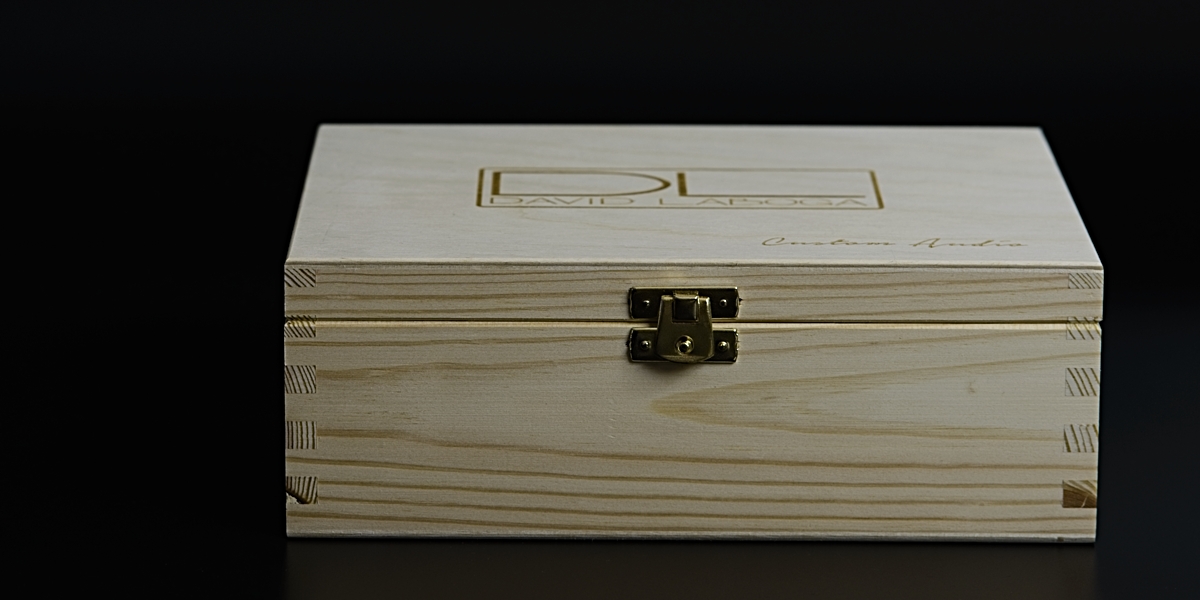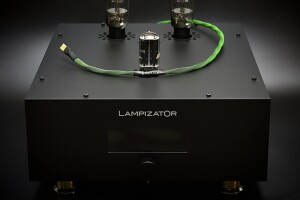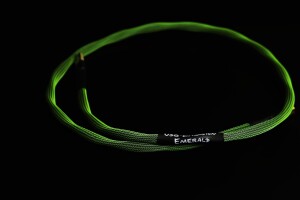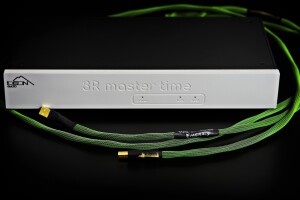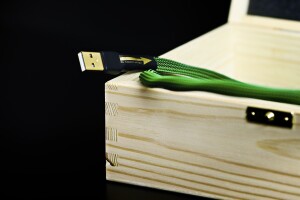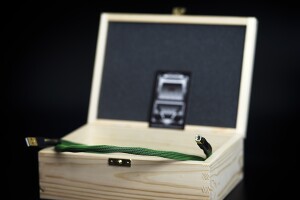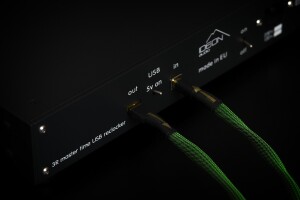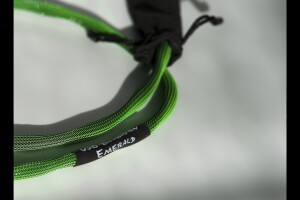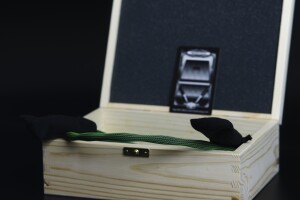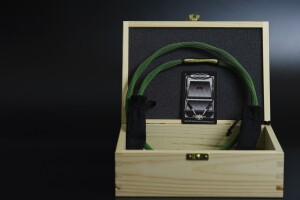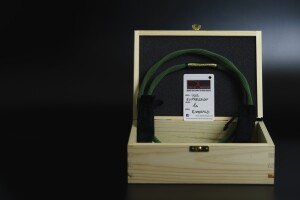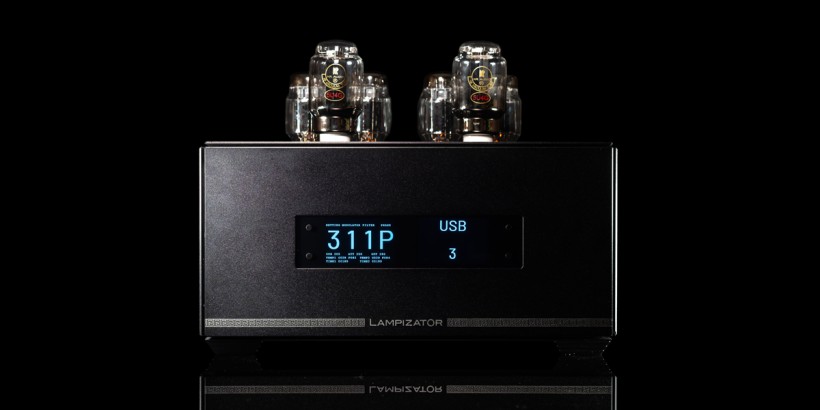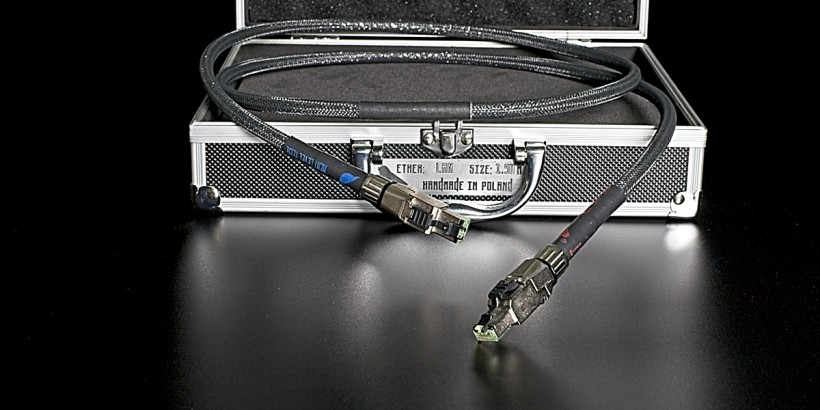The pro and home audio markets are often seen as two sides of the barricade, so to speak, and yet there are many renown manufacturers providing their products for both. For this particular review I received the David Laboga Expression Emerald USB cable from a company that until recently had specialized in cables for the professionals. How good a job did it do in an audiophile system? Keep reading to find out.
Introduction
Eight years ago I participated in a short but very interesting audiophile trip to Finland. We went there primarily to visit a renown loudspeaker manufacturer, Amphion, but its boss, Anssi Hyvönen wanted to make our visit even more exciting and to, in a way, prove one of his unusual ideas. To do that he prepared a few surprises for us and one of them was a visit to the renown Finnish mixing and mastering studio called Chartmakers. Anssi wanted to us to see his idea being implemented in the real world. For those of you who have never heard of it before let me explain that his idée fixe was, and still is (as far as I know), to ensure that the same loudspeakers, Amphion’s obviously, are used not only by end users for listening to the music at their homes, but also by people creating recordings (i.e. musicians and sound engineers in studios). The assumption behind the whole idea is simple – if both, musicians, music production studios (recording, mixing, mastering), and ultimately fans use the same speakers, the latter will actually get the closest possible rendition of the content the former intended to create. It’s an intriguing idea, isn’t it? While it is not possible to introduce it widely through a single loudspeakers brand, the reasoning seems to have a point.
Why am I mentioning all that in the David Laboga’s cable test? There are two main reasons for that, actually. Well, the first one is there in the story of cooperation between Amphion and Chartmakers. The whole „affair” started with guys in the studio trying out Amphion monitors, and if I remember correctly, they even offered some suggestions that helped the manufacturer to improve his speakers. After these speakers already became a tool used on everyday bases in the studio, Anssi started supplying them with other audiophile products, including cables (Tara Labs to be specific). I remember that Henkka ( Niemistö – one of the studio heads) told us that when Anssi brought him these cables, he replaced ones he’d been using with them in his studio, listened to them for some time and concluded that they were doing a fine job. Just fine, but nothing more than that. He didn’t feel like they offered anything in particular to convince him to replace his trusted pro cables. But then he switched back to the previously used (unspecified ones, just from the pro market) and … almost immediately he felt as if his system’s performance took a significant hit, as the sound’s quality degraded. And this is a short version of the story of how audiophile cables became a permanent element of a system in a professional recording and mastering studio. Anssi and Henkka planned to conduct further experiments with other audiophile products, simply because Chartmakers engineers experienced themselves, that high quality audiophile products may help them do their job.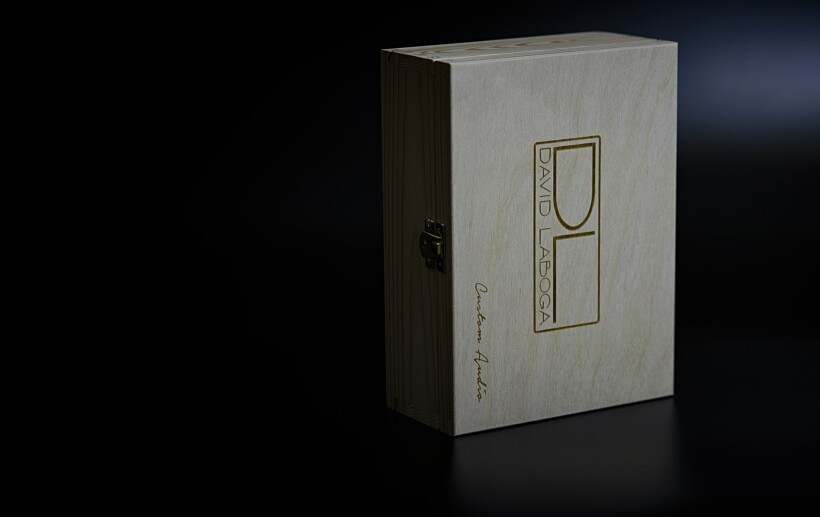
The second reason is the fact that until now David Laboga was known mainly among musicians and studio engineers all over the world. He’s been making guitar speakers but also microphone and instrument cables, including ones for guitars for them. As he told me, his cables were used by numerous famous musicians while they were recording their albums. So he operated “on the other side of the barricade”, as some audiophiles see it (especially when some recordings do not satisfy their high expectations). Hence, in this case, we are dealing with a situation somewhat opposite to the one of Amphion – the manufacturer of components for professionals decided that if they worked so well for them, why wouldn’t they do equally good job for the music fans in their home audio systems? Some audiophiles have been using Mr. David’s products for some time now, and not just here in Poland. The complete lineup includes analogue cables – interconnects, speakers cables and jumpers, and digital ones including USB, Ethernet, coaxial SPDIF and AES/EBU ones. For this test I received the entry level USB model, one of the three in the current lineup, so that I could assess it in my system from and audiophile and above all music fan perspective and share my findings with our Readers. This model comes from the Expression line and is called Emerald. As Mr. Laboga told me, while it has already been used and appreciated by numerous professionals in their studios, it is intended primarily for the audiophile market.
Obviously, Mr. Laboga is not the first one who decided to offer his products to both, professionals and audiophiles, although most of the brands supplying both, offer loudspeakers and electronics, and only few of them provide cables. The few that do, usually prepare separates product lines for professional and home users. It’s just that most studios still use cables dedicated to professional applications, and cases such as the aforementioned Chartmakers are pretty rare. I don’t want to get into the discussion whether it’s a good or a bad thing. The fact is that most sound engineers who created the recordings commonly recognized as the best ones ever made (most of them actually come from 30-40-50 years ago) did not use audiophile cables (simply, back then, there were no audiophile cables). Yet, these old recordings sound better than most produced in the recent years. On the other hand, the given example proves that high-class audiophile cables can also be appreciated in the professional world. Given a chance, obviously. My point being – both „sides” should keep an open mind and simply use these components that best suit their needs regardless of whether they are intended for professional or audiophile market.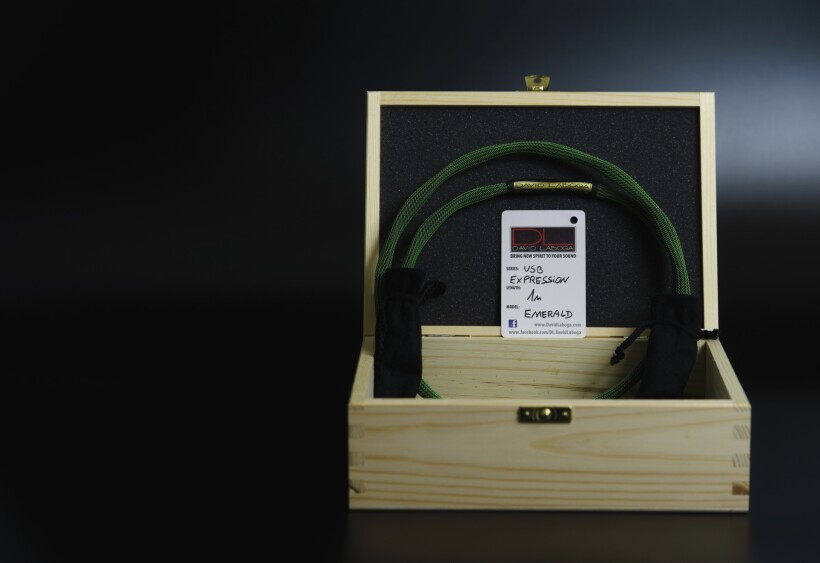
The Expression Emerald USB is an even more particular case, since it’s not an analog, but a digital cable. The vast majority of people from the pro market, plus still a large group of audiophiles, claim that when it comes to digital signals it’s all about zeros and ones so cables don’t matter and the cheapest ones do as good a job as audiophile ones. And yet, the pro market specialist, David Laboga, developed a series of USB (as well as Ethernet) cables that are gaining more and more traction among studio professionals, and recently have also began to conquer audiophile market as well. The „conquest” is obviously a bit of exaggeration (at least for now), as the company is still at the beginning of its path. Still, brand’s roots in the pro market and the fact that they decided to deliver their cheapest of the three USB models they currently offer for test, which, if you know audiophile market reality, is relatively inexpensive, testifies to a high level of confidence. The latter is surely based on the fact that the testimonies from the users of David Laboga cables are very positive among both, professionals and audiophiles.
We talked about it with Mr. David, who emphasized that while it’s true that he does offer two more expensive models – Sapphire and Ruby – and that they do deliver an even better performance, it entails a much higher price. Therefore, they are a proposal for the most demanding customers owning the most expensive systems, which will fully benefit from the enhanced performance. The tested Expression Emerald USB is supposed to be a kind of a “golden mean” for all those who are looking for a high class, refined sound for a (relatively) friendly price. He honestly admitted that this model is to constitute the bulk of sales on both, the professional and audiophile markets, and probably only a relatively small group of audiophiles will choose the more expensive models. The approach and honesty of the manufacturer earned him my respect from the start.
Below you will find, what Mr. Laboga has to say about his cables:
We have invested, and are continuing to do so, a lot of effort (and money) in development. It has been a development and testing journey of many years to build the Expression series cables. Before our cables goes to our customers we test them in many different environments and systems, with many different customers who have different music taste, and proudly we can say that we have developed what we believe to be one of the best USB cables on the market.
USB cables are one of the most important cables in our audio chain as they convey the original source signal to the rest of the system. If the quality of the initial source signal is the best it can possibly be, there will be fewer problems further along the signal chain that we may feel compelled to try and fix maybe by changing speakers, amps, different interconnects and speaker cables, etc. Of course, every component in the system is important and has an effect (positive or negative) on the fidelity of the final output, but ensuring the source signal is as pure and unadulterated as possible will be a significant factor in delivering the best sound possible, both in terms of mastering and in terms of music reproduction.
Among professional users of the Expression Emerald USB who have already expressed their appreciation of its qualities, the manufacturer mentions Mr. Hiro Furuya, a mastering engineer, working with artists such as: Eric Clapton, TOTO, Billy Joe, Elton John, and Rod Stewart. The cable in question is also used by Mr. Maor Appelbaum, another famous mastering engineer, who, for a change, cooperates with such artists as: Annihilator, Eric Gales, Faith No More, and Sabaton. The question I shall try to answer in this review is: will a cable that music studio professionals hold in such a high regard do an equally impressive job in an audiophile system? Let’s check.
Design & Features
We agreed that Mr. David would send me two Emeralds, both in the standard version (i.e. terminated with A and B type plugs, although one can order this cable with almost any other USB termination), one 2m and the other 1m long. Having these two at my disposal, I was able to connect my custom audio server directly with the USB input of my reference LampizatOr Pacific DAC (and some other devices), and using the second cable, I could include additionally the Ideon Audio 3R Master Time USB regenerator (see HERE) in the signal’s path. The cables arrived in a nice, wooden padded box with the manufacturer’s logo engraved on the lid. Solid gold-plated plugs were additionally secured with small, black pouches made of soft material. Some may consider these elements unimportant, but we all like to get our now „audio toys” in a perfect shape, don’t we? Such a packaging will make sure of it. The color of the cable’s sleeve explains its name – it is green (at least from a male point of view – after all, an average representative of the uglier sex distinguishes no more than ten basic colors :-)). Those with a more sophisticated „color pallet” may recognize it as emerald (I guess), as suggested by the model’s name. Besides the eye-catching color, it doesn’t really stand out among other cables, but nor should one expect it to – after all pro-market roots mean that any product should be well-made, durable, do its job as reliably as possible, but doesn’t need to win a beauty pageant, simply because it doesn’t effect its performance.
For the record, let me add that the standard lengths are 0.3; 0.5; 1; 2 and 3m, but custom orders are welcomed. Standard termination includes USB Type A and USB type B plugs, but the list of options is much longer: A – B; A – C; C – B; C – C, C – micro USB B; A – micro USB B; A – mini USB B; C – mini USB B. The list clearly shows that these cables are not intended only for connecting computers / file players / streamers with DACs, but also for portable devices, or actually almost any device with music playback capability and any sort of USB input or output. As for the internal design, without cutting the cables open we have to rely on the information provided by the manufacturer. According to his declaration he uses highest purity oxygen-free copper as a conductor, and the cables are terminated with custom-made gold-plated plugs. Although termination should make it clear, there are still markings (arrows) showing the directivity of a cable.
I should add, that actually, since the first two cables arrived for this review, Emerald has evolved a bit based on feedback from a number of users. What changed is the even better isolation of the 5V power run from the signal conductor. Due to that fact the cable has become a bit thicker and stiffer (which I know because I later received also next two versions), but still flexible enough not to make connecting it problematic. The workmanship and finish are just good, solid – no complains on my side. Few months of intense usage and no visible wear and tear – that confirms durability of this product.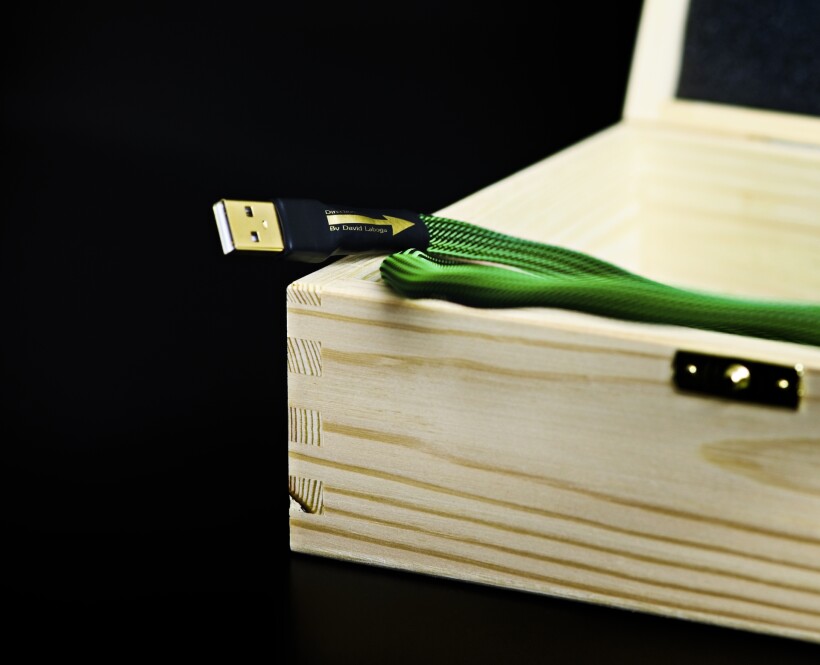
Sound
As I had the Expression Emerald USB cables at my disposal for a few months before finalizing this review, it gave me an opportunity to use them not only with my dedicated server, but also with other sources, such as the Silent Angel Rhein Z1 or the Roon Nucleus. I could also use it to deliver signal from source to several various DACs with my reference LampizatOr Pacific being the one most of the time, but, to name a few, I also plugged the Expression Emerald to USB inputs of the Thievan Labs Tube Music Processor 9038, as well as excellent CD players with digital inputs, i.e. the reference Acoustic Research CD9 SE and a more reasonably priced but also offering a very good sound, Ayon CD10 mkII, or finally to the DAC 50 module in the Accuphase E-380 integrated.
Let me add that on a daily basis I use two relatively inexpensive, yet great-sounding (this is, obviously, a simplification that I may use in this review from time to time, as cables do not have their own sound, they affect the sound) USB cables. The longer one is FiData HFU2, and the shorter is Tellurium Q Silver. I use FiData to connect a custom audio PC directly to the LampizatOr Pacific, and both cables, whenever I decide to add the excellent USB signal regenerator, i.e. 3R Master Time by Ideon Audio, to the mix. Among other USB cables I have tested to date, in my system only a handful (if any) introduced further performance enhancement significant enough to make me considering investing in them. One of the few examples was the WestminsterLab USB Standard (see HERE), but it, and the other few, cost quite a lot. So I wondered what would the replacement of my USB cables with the tested, not so expensive David Laboga Expression Emerald USB bring to the equation? Long story short, quite a lot!
Let’s start with the first impression. On the one hand it may be misleading at times, give you a wrong idea about tested component. In my case, though, after listening to hundreds, and probably even over a thousand various components for my reviews, I dare to say, that in most (not all!) cases my first impression holds also in the final assessment. With the David Laboga Expression Emerald USB cable, the first thing that caught my attention was how extraordinary effortless, open, fluid and natural was the presentation. All these elements combined make up what is often referred to as an analogue sound, although, obviously, there is no one unambiguous definition of this term. What does an analogue sound mean for me? It’s when (while listening to a digital source) the difference between what it offers and my preferred sound from analogue components, or rather analogue carriers, so primarily turntables / vinyl records, becomes blurred. The point is not that the digital system should sound exactly the same as my turntable, but that, to simplify it as much as possible, me returning to listening to vinyl records after listening to a digital source does not immediately cause a sigh of relief.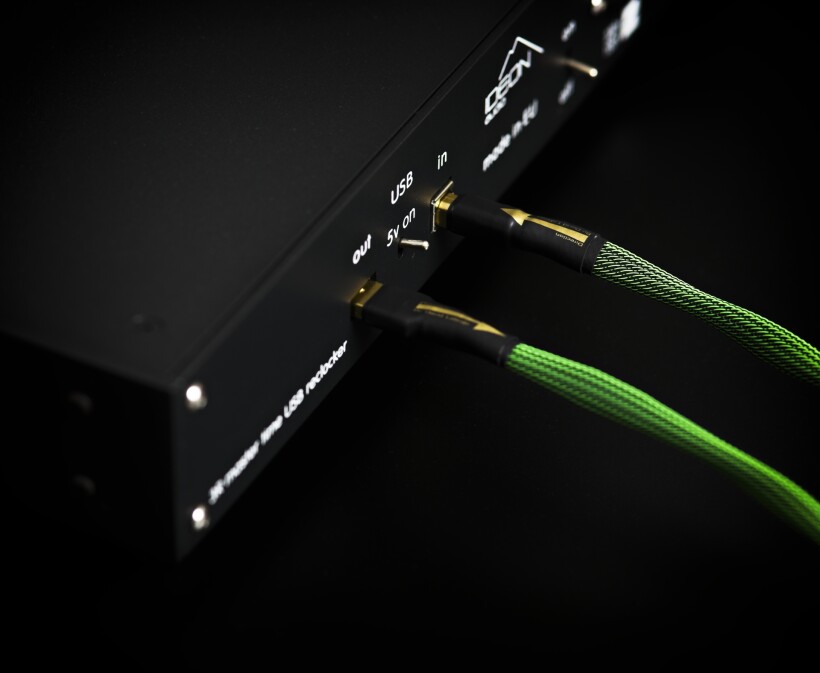
To be clear, I feel this sort of relief in most digital sources cases, even those very expensive ones (also because my J. Sikora Standard Max is one of the top performers there are on the market). Ever since I became a proud owner of the LampizatOr Pacific DAC I started to listen to much more music from digital files (mostly DSD) than I’d used to before, and yet the turntable remains my number one choice anyway. Of course, this is partly a matter of individual preferences and does not diminish LampizatOr’s remarkable performance in any way, because in terms of its sonic class it is (almost) on par with the Sikora’s masterpiece. That is why the effect of “being relieved” after switching from the Pacific to the turntable is (almost) absent. Returning to the subject of this test, David Laboga’s cable caused a further reduction of this already subtle difference between the DAC and the turntable. I chose both of the USB cables mentioned before for the same reason (apart from their other qualities, of course), but after the first few albums it was clear that in terms of sounding “analogue”, the Expression Emerald offers yet another step in the right, at least from my point of view, direction.
Although the very fact that the sound was “friendlier” (because analogue sound is, in my opinion, obviously, friendlier) than its digital counterpart already suggested also the top level performance altogether, as a reviewer I had to try and be a bit more specific for you, our Readers, to give you a better idea of what to expect from the David Laboga Expression Emerald USB. To do this, I started comparing individual tracks, quickly switching between the cables to point out the differences between them. One of them was the opening track from the Masahiko Togashi and Isao Suzuki’s “A day of the sun”. It was almost immediately clear that there were two elements of the performance that the Expression Emerald was able to convey even better than my FiData. First of all, the bass range, quite an important element of this piece, was even better extended and had even more weight, more slam, but at the same time it was still properly agile, punctual and perfectly differentiated.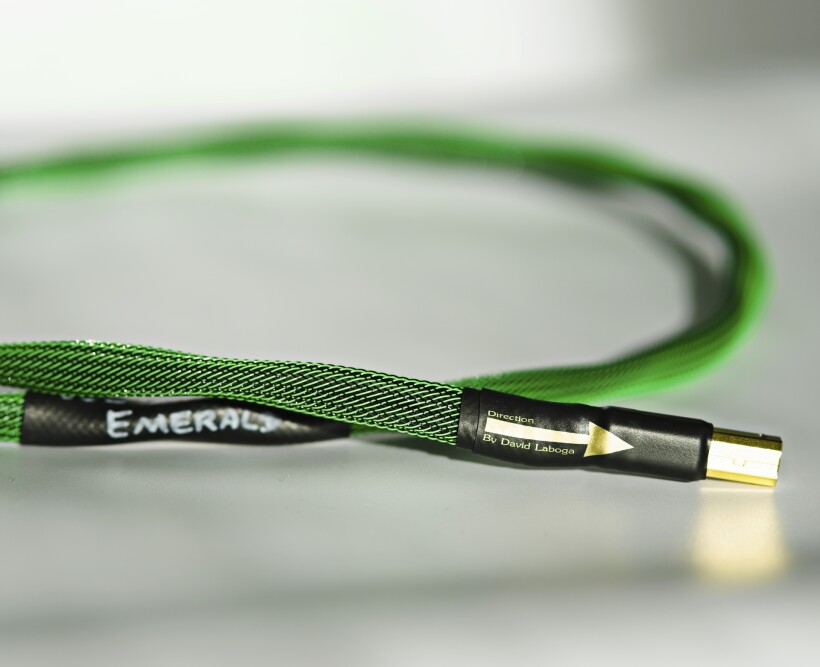
The second quality was, as easily recognizable, further enhancement in terms of spatial aspects of the recording. To be clear – I’d always enjoyed the way FiData presented the soundstage and imaging, but David Laboga’s cable proved these could be conveyed in an even better, more realistic way. The point was not even the size of the soundstage as such – I had no complains about it using the Japanese cable. It was more about the precision of the placement of phantom images on the stage, as well as their definition – shape and weight. In both cases, the so-called presence of the musicians was delightful, convincing, but the Polish cable achieved it using a higher precision, even sharper or clearer individual images, while the Japanese one used weight and three-dimensionality, but the latter was more about palpability or presence than precision of their rendering. The Emerald also reproduced the acoustics of the recording in an even better way than the FiData. Elements such as reverberation or decay delivered just slightly better with the David Laboga’s cable, gave the realism of the presentation an additional, very important dimension.
In the following tracks of this, very well-recorded, album (which sounded so good I simply had to listen to it in full before the next quick comparisons), also the piano sounded mighty impressive. It was large, powerful, the sound was dense, vibrant, but also beautifully fluid. I truly appreciated how effortless, open and, simply put, real (as far as possible in terms of the reproduction of the recorded sound) the performance was. Also because it seemed as if I could feel the lowest notes in an almost physical way, that I could “see and feel” the mass and the power of this instrument. For a change, due to this exceptionally convincing way of presenting the space and acoustics or ambiance of the recordings, the drums, that the sound engineer spread between both channels, kept surprising me. The recording might not be truly realistic in this regard, as the drums should be localized in a specific, limited space, but the sound engineer had decided otherwise to make it more interesting, and the high precision cable, such as the Expression Emerald, gave me a chance to contemplate his idea, immerse in it effortlessly and simply enjoy it fully.
As I mentioned, during the course of auditions for this review, I had an opportunity to follow the evolution of this model. The manufacturer kept improving the isolation between power and signal wires. It did not actually change the sonic character of the Expression Emerald, but each subsequent improvement made the background noise even quieter. And although it’s about a noise that is not actually audible as such, the improved versions offered, as is often called, a „blacker” background. It may seem like not much of an improvement. But once you compare two products that differ only with a level of the background noise, you will quickly realize that the timbre and textures are better pronounced, more intense, that you can hear more of those tiny little details, subtleties. It is not really because there are more of them, or in other words that the resolution improved (because in this case it was high from the first version I listened to), but because these tiniest pieces of information are presented in a clearer way due to the blacker background. That, consequently, enhances richness and intensity of the presentation, which translates directly to its realism. And the bar for the latter, due to the Expression Emerald USB, was raised to an even higher, absolutely stunning level. The better (higher quality) the recording I played, the clearer and more impressive it became.
The next track selected for comparisons came from an album recorded by Yo-Yo Ma and Bobby McFerrin. The combination of the master’s cello with McFerrin’s remarkable vocals yielded spectacular effects. And this time it was also the Polish cable that ultimately came out on top in this comparison, but … When it came to the cello, I had no doubts – sound with the Expression Emerald was deeper, fuller, the timbre a bit more saturated, and an additional advantage was a bit better micro-dynamics. However, I could not really find any advantage of any of these cables comparing only the vocals. They were not identical – the Japanese cable saturated the voice a bit more, the Polish defined each sound more precisely, hence more faithfully. The differences between the two were tiny, but notable. Summa summarum, in my ears, in terms of the vocal presentation there was a tie between Emerald and FiData. It was more a matter of taste or preference than actual advantage of one of them over the other.
To be sure, that this is the case for vocals in general, next I listened to a song from the Whitesnake’s acoustic live performance. This time vocal was accompanied by a guitar. Despite the fact, that these are two completely different recordings my conclusions were still similar. I did not prefer one presentation of David Coverdale’s voice over the other, but I did hear a fuller, deeper-sounding, more resonant guitar with the Expression Emerald. As a fan of Japanese audio components, including cables, that are usually fabulously musical, dense, saturated, natural, and particularly impressive when it comes to vocals, I think that this draw was a great success for the Emerald (or rather its designer). In this particular respect, other products rarely come even close, let alone match, to my ear, of course, the high quality Japanese competitors.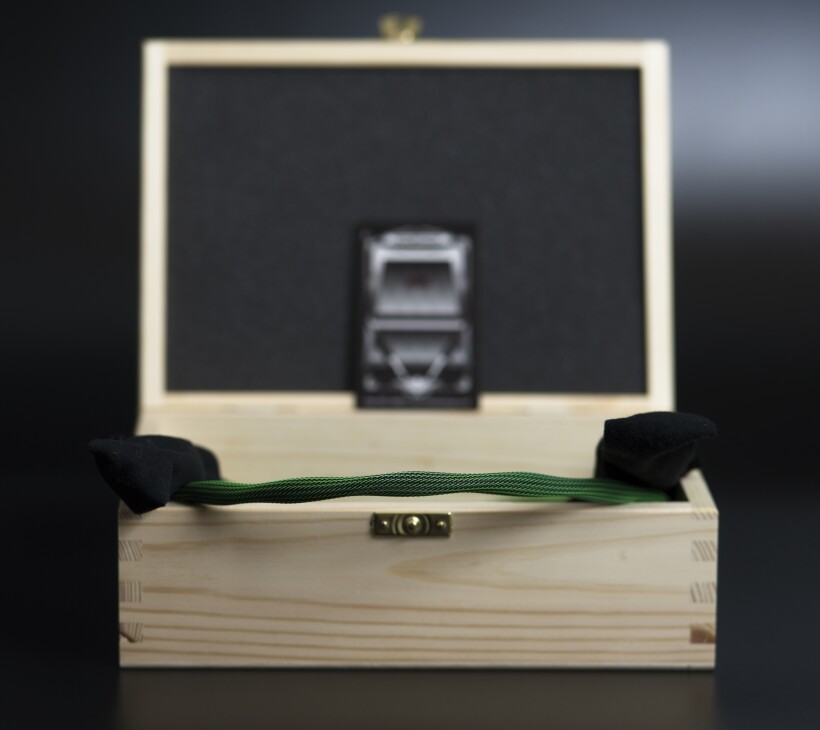
Listening to one track first, switching cables every few tens of seconds, and then moving on to listening to longer fragments of Lee Ritenour’s album, I heard somewhat smaller differences. The Emerald was able to provide a bit more powerful bass slam and differentiate the lower end slightly better. The guitar with David Laboga was a bit more precise due to slightly better differentiation too. Trying real hard to find more differences, I could ultimately say that the dynamics seemed to be a bit better with the tested product. Generally, however, identifying clear differences between these two cables listening to such, electric music was definitely more difficult, much less unambiguous. Subsequent albums with electric music confirmed this thesis – the overall advantage of the Expression Emerald is clearer when listening to vocals and acoustic instruments, provided, of course, at least decent quality of recordings being played as that’s definitely a „high fidelity” cable. That was also a reason why the Polish cable became my favorite for rock recordings, particularly those with vocals. The voices of, for example, David Gilmour, Peter Gabriel, Steven Tyler, and Janis Joplin, as if in line with the name of David Laboga’s cable series, sounded stronger and more expressive, which made a big difference particularly in the cases of the last two.
Last but not least, I took an advantage of having two Emeralds at my disposal. I could use one plugged between the server and the Ideon Audio 3R Master Time and the second one between the latter and my DAC. This comparison introduced two additional variables – the USB signal regenerator and the second cable. As I’ve already mentioned before, in my system I use two different models from two different manufacturers – FiData and Tellurium Q. This part of the test was important for me, and I assume for others who use either Ideon or any other USB signal enhancement device, to find out whether it is worth to invest in a pair of Expression Emerald USB cables. Comparing these two pairs I found out that two Expression Emeralds fared even better compared to the FiData and TelluriumQ duo, than a single one against Japanese cable. They did not introduce new features or advantages, but rather deepened or further enhanced the ones already described above.
One of David Laboga’s cables connecting directly server with DAC did already a great job, but two of them seemed to even increase the advantage of the reviewed model over the ones I’d used so far. The difference (or further improvement) was smaller in scale than when comparing single units, but there was no doubt that the two Emeralds delivered an even better performance. Although, of course, it is possible that the second cable simply benefited from the signal being already “enhanced/regenerated” by Ideon and therefore it was able to deliver an even better performance. Anyway, if you use any USB signal “enhancers” in your system which most likely requires usage of two USB cables, and you want to improve the overall performance, you can start with one Expression Emerald USB cable for sending signal to your DAC. Depending on the cable you’ve been using so far, obviously, in most cases you should notice a significant improvement of the sound quality, at least in the areas I described. Later you can add another one to the mix and check out for yourself whether in your case the extra investment justifies the extra expense. In my system, the answer to this question was a resounding YES!
Summary
Using David Laboga’s cables in my reference system for a long time I was able to test them extensively, that is, use them in various setups, which is not always the case with reviewed items. Each time though, the conclusions were similar. It is an extremely “analogue sounding”, in the best sense of this term, USB cable. It is extremely smooth, fluid and refined, offers high resolution, and shows a wealth of information in a very clear and precise way against a pitch black background. On top of that, it renders a huge, precisely arranged soundstage and reproduces acoustics of any recordings in a very natural, convincing way. It’s not that type of component that will sweep you off your feet the second you plug it into your well-known, high-class system. You will rather learn to appreciate its value gradually, and the moment of absolute clarity will most likely come when after listening to it for a longer time you will switch back to your previous cable. Even if it’s a really worthy competitor, Emerald will clearly prove its merits. It’s very likely that you will find out that the David Laboga Expression Emerald USB cable simply offers… more music in music, so to speak, without sacrificing resolution, precision, dynamics, PRAT, or anything else for that matter. If that’s what you’re looking for, make sure to try the Emerald out in your setup. Compared to many competitors, it does not cost a fortune, and yet it may well be the single piece of the puzzle that will finally show you the full potential of your system even if it is quite an expensive one.
Prices (when reviewed):
- David Laboga Expression Emerald USB:
20cm: 429 EUR50cm: 469 EUR1m: 529 EUR1,5m: 589 EUR2m: 639 EUR3m: 709 EURCustom order, each additional 50cm: 49 EUR
Manufacturer: Music Distribution ; David Laboga Custom Audio
Associated equipment:
- Analogue front end: J.Sikora Standard MAX turntable, J.Sikora KV12 tonearm, AirTight PC-3, phonostages: Grandinote Celio mk IV, ESE Lab Nibiru V 5.
- Digital source: a passive, custom PC with WIN10, Roon, Fidelizer Pro 7.10, JCat USB Femto card with iFi power supply, Hdplex linear power supply for PC, JCAT USB Isolator
- D/A Converter: LampizatOr Pacific +Ideon Audio 3R Master Time (USB signal regenerator)
- Power amplifier: GrandiNote Shinai, LampizatOr Metamorphosis, Art Audio Symphony II (modified)
- Preamplifier: Audia Flight FLS1
- Loudspeakers: GrandiNote MACH4, Ubiq Audio Model ONE Duelund Edition.
- Interconnects: Hijiri Million, Siltech Crown Princess, Hijiri HCI-20, TelluriumQ Ultra Black, KBL Sound Zodiac XLR, FiData HFU2, TelluriumQ Silver USB
- Speaker cables: Siltech Classic 770L, LessLoss Anchorwave
- Power cables: LessLoss DFPC Signature, Gigawatt LC-3
- Power: Gigawatt PF-2 MK2 and Gigawatt PC-3 SE Evo+; a custom power line with Gigawatt LC-Y in-wall cable; Gigawatt G-044 Schuko and Furutech FT-SWS-D (R)
- Racks: Base VI, Rogoz Audio 3RP3/BBS
- Anti-vibration accessories: ROGOZ-AUDIO SMO40 and CPPB16 platforms and ROGOZ AUDIO BW40MKII feet, Franc Accessories Ceramic Disc Slim Feet and Wood Block Platform


